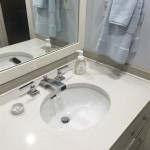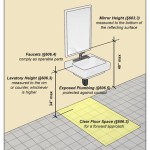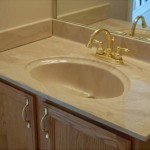Addressing Smelly Drains in the Bathroom: Causes and Solutions
A persistent unpleasant odor emanating from bathroom drains is a common household problem that can significantly impact the overall comfort and hygiene of a living space. This issue is not merely an inconvenience; it often signals underlying problems within the plumbing system that, if left unaddressed, can lead to more severe and costly repairs. Understanding the potential causes of these odors and implementing appropriate preventative and remedial measures is crucial for maintaining a healthy and pleasant bathroom environment.
The offensive smells associated with drain issues typically arise from a combination of factors, including the accumulation of organic matter within the drain pipes, the presence of anaerobic bacteria, and problems with the plumbing system's venting or drain traps. Identifying the specific root cause requires a systematic approach, starting with an assessment of the frequency and intensity of the odor, as well as any associated plumbing fixtures or appliances. This article will explore the most prevalent causes of smelly bathroom drains and provide practical solutions to mitigate and eliminate these issues.
Biofilm Buildup and Decomposition
One of the most significant contributors to foul-smelling bathroom drains is the accumulation of organic material, commonly referred to as biofilm. This slimy layer forms as a result of the constant flow of water, soap residue, hair, skin cells, and other debris through the drain pipes. Over time, this organic matter adheres to the interior walls of the pipes, creating an environment conducive to bacterial growth.
Specifically, anaerobic bacteria thrive in the oxygen-depleted environment within the biofilm. These bacteria decompose the organic matter, releasing foul-smelling gases as byproducts. These gases often include hydrogen sulfide, a compound recognizable by its distinctive "rotten egg" odor, which is a frequent characteristic of smelly drains. The warmer temperatures and moist conditions prevalent in bathrooms further accelerate the decomposition process and subsequent odor production.
Addressing biofilm buildup requires a multi-faceted approach. Regular flushing of the drains with hot water can help dislodge some of the accumulated debris. However, a more thorough cleaning is often necessary. Commercial drain cleaners containing enzymes or bacteria can be effective in breaking down the organic matter. Alternatively, a homemade solution of baking soda and vinegar can be used. Pouring baking soda down the drain, followed by vinegar, will create a fizzing action that helps to loosen and remove the biofilm. After allowing the mixture to sit for approximately 30 minutes, flushing the drain with hot water will help clear away the loosened debris. It is important to note that while chemical drain cleaners containing harsh chemicals may seem like a quick fix, they can damage pipes over time and should be used with caution and according to the manufacturer's instructions.
Preventative measures are crucial in minimizing biofilm formation. Regularly cleaning sink stoppers and drain strainers to remove hair and debris can significantly reduce the amount of organic matter entering the drain pipes. Avoiding the disposal of grease, oil, and food scraps down the drain is also essential. Periodically flushing the drain with hot water and employing enzymatic drain cleaners as a preventative measure can help maintain a cleaner drain system and prevent the buildup of odor-causing bacteria.
Drain Trap Issues: Dry Traps and Siphonage
The drain trap, typically a U-shaped section of pipe located beneath the sink or shower, serves a crucial function in preventing sewer gases from entering the bathroom. This trap is designed to hold a small amount of water, creating a seal that blocks the passage of noxious odors. When the drain trap malfunctions or dries out, this protective barrier is compromised, allowing sewer gases to escape into the bathroom.
A "dry trap" occurs when the water in the trap evaporates due to infrequent use of the fixture. This is particularly common in guest bathrooms or infrequently used sinks or showers. Without a water seal, sewer gases have a direct pathway to enter the room. Identifying a dry trap is usually straightforward; the smell will typically be noticeable and localized to the specific fixture with the dry trap.
Another cause of drain trap malfunction is siphonage. Siphonage occurs when negative pressure within the plumbing system pulls the water out of the drain trap. This can happen when other fixtures in the house are used simultaneously, creating a vacuum effect that draws the water out of the trap. Inadequate venting within the plumbing system is a common cause of siphonage. Proper venting allows air to enter the drain pipes, equalizing the pressure and preventing the water in the drain trap from being siphoned out.
Addressing drain trap issues requires specific solutions depending on the cause. For a dry trap, simply running water down the drain for a few minutes will replenish the water seal and eliminate the odor. To prevent dry traps, periodically running water down infrequently used drains is recommended. For siphonage, it is crucial to inspect the plumbing system's venting. Blocked or improperly installed vents can create negative pressure, leading to the siphoning of water from drain traps. A professional plumber may be required to inspect and repair the venting system to address this issue. Modifying plumbing without proper knowledge can violate building codes and create dangerous situations. If the trap itself or connecting pipes have leaks, the water will escape, and the smelly gas can enter the bathroom. In this case, the drain trap and related pipes may need to be replaced. Inspecting the trap and connections under the sink is a necessary step in tracking down the source of the smell.
Ventilation Problems and Sewer Gas Intrusion
The plumbing system relies on a series of vents to maintain proper air pressure and facilitate the smooth flow of wastewater. These vents typically extend from the drain pipes to the roof of the building, allowing air to enter the system and equalize pressure. When these vents become blocked or damaged, it can disrupt the airflow and lead to sewer gas intrusion into the bathroom.
Blocked vents can occur due to a variety of reasons, including the accumulation of debris such as leaves, bird nests, or even ice. Damage to the vent pipes, such as cracks or breaks, can also compromise the system's ability to function properly. When the vents are blocked or damaged, negative pressure can develop within the drain pipes, drawing sewer gases into the building through drain traps or other openings.
Identifying ventilation problems can be challenging, as the source of the odor may not be immediately apparent. A consistent and widespread sewage-like smell throughout the bathroom, or even the entire house, is a strong indication of a ventilation issue. Other signs may include gurgling sounds from drains or slow-draining fixtures, which can indicate a pressure imbalance within the system.
Addressing ventilation problems typically requires the expertise of a qualified plumber. Inspecting the vent pipes for blockages or damage is the first step. Removing any obstructions from the vents and repairing or replacing damaged sections of pipe can restore proper airflow and eliminate the source of the odor. In some cases, the vent pipes may need to be extended or relocated to ensure adequate ventilation. Furthermore, ensuring that all plumbing fixtures are properly sealed and connected to the drain system can prevent sewer gases from escaping through unintended openings. Proper sealing around toilets and sinks is crucial in preventing the intrusion of sewer gases into the bathroom.
In conclusion, addressing smelly drains in the bathroom involves identifying the root cause of the odor and implementing appropriate solutions. Biofilm buildup, drain trap issues, and ventilation problems are common culprits that can be effectively addressed with proper cleaning, maintenance, and repairs. A systematic approach to diagnosing and resolving these issues is essential for maintaining a healthy and pleasant bathroom environment.
:max_bytes(150000):strip_icc()/__opt__aboutcom__coeus__resources__content_migration__mnn__images__2018__08__sink_drain-351af8e441034f319fe07f00c091d8b6.jpg?strip=all)
How To Clean A Smelly Drain Naturally

Why Does My Shower Drain Smell Bad Kay Plumbing Heating And Cooling

How To Deal With Smelly Drains Cleanipedia Za

What Causes Bathroom Drains To Smell

Prevent Drain Smells Deodorize Your Drains

How To Clean A Stinky Sink Drain By Home Repair Tutor
My Bathroom Smells Bad But Only When Its Hot Outside It Also Will Slightly Go Away I Run The Sink And Toilet Bathtub Any Thoughts On What Is

How To Get Rid Of Sewage Smell In Your Bathroom Bond Cleaning Adelaide

Two Easy Ways To Fix A Smelly Shower Drain I Rick S Plumbing

What Causes Smelly Drains In The Bathroom
Related Posts







